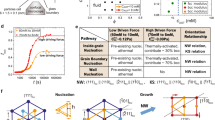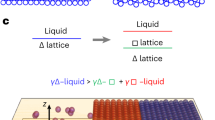Abstract
Crystal surfaces typically melt into a thin liquid layer at temperatures slightly below the melting point of the crystal. Such surface premelting is prevalent in all classes of solids and is important in a variety of metallurgical, geological and meteorological phenomena1. Premelting has been studied using X-ray diffraction2 and differential scanning calorimetry3, but the lack of single-particle resolution makes it hard to elucidate the underlying mechanisms. Colloids are good model systems for studying phase transitions4 because the thermal motions of individual micrometre-sized particles can be tracked directly using optical microscopy5. Here we use colloidal spheres with tunable attractions to form equilibrium crystal–vapour interfaces, and study their surface premelting behaviour at the single-particle level. We find that monolayer colloidal crystals exhibit incomplete premelting at their perimeter, with a constant liquid-layer thickness. In contrast, two- and three-layer crystals exhibit conventional complete melting, with the thickness of the surface liquid diverging as the melting point is approached. The microstructures of the surface liquids differ in certain aspects from what would be predicted by conventional premelting theories. Incomplete premelting in the monolayer crystals is triggered by a bulk isostructural solid–solid transition and truncated by a mechanical instability that separately induces homogeneous melting within the bulk. This finding is in contrast to the conventional assumption that two-dimensional crystals melt heterogeneously from their free surfaces3,6 (that is, at the solid–vapour interface). The unexpected bulk melting that we observe for the monolayer crystals is accompanied by the formation of grain boundaries, which supports a previously proposed grain-boundary-mediated two-dimensional melting theory7. The observed interplay between surface premelting, bulk melting and solid–solid transitions challenges existing theories of surface premelting and two-dimensional melting.
This is a preview of subscription content, access via your institution
Access options
Subscribe to this journal
Receive 51 print issues and online access
$199.00 per year
only $3.90 per issue
Buy this article
- Purchase on Springer Link
- Instant access to full article PDF
Prices may be subject to local taxes which are calculated during checkout




Similar content being viewed by others
References
Dash, J. G., Rempel, A. W. & Wettlaufer, J. S. The physics of premelted ice and its geophysical consequences. Rev. Mod. Phys. 78, 695–741 (2006)
Frenken, J. W. M. & van der Veen, J. F. Observation of surface melting. Phys. Rev. Lett. 54, 134–137 (1985)
Zhu, D.-M., Pengra, D. & Dash, J. G. Edge melting in two-dimensional solid films. Phys. Rev. B 37, 5586–5593 (1988)
Li, B., Zhou, D. & Han, Y. Assembly and phase transitions of colloidal crystals. Nature Rev. Mater . 1, 15011 (2016)
Crocker, J. C. & Grier, D. G. Methods of digital video microscopy for colloidal studies. J. Colloid Interface Sci. 179, 298–310 (1996)
Dash, J. G. History of the search for continuous melting. Rev. Mod. Phys. 71, 1737–1743 (1999)
Chui, S. T. Grain-boundary theory of melting in two dimensions. Phys. Rev. Lett. 48, 933–935 (1982)
Elbaum, M., Lipson, S. G. & Dash, J. G. Optical study of surface melting on ice. J. Cryst. Growth 129, 491–505 (1993)
van der Gon, A. W. D., Gay, J. M., Frenken, J. W. M. & van der Veen, J. F. Order–disorder transitions at the Ge(111) surface. Surf. Sci. 241, 335–345 (1991)
Carnevali, P., Ercolessi, F. & Tosatti, E. Melting and nonmelting behavior of the Au(111) surface. Phys. Rev. B 36, 6701–6704 (1987)
Rogers, W. B. & Manoharan, V. N. Programming colloidal phase transitions with DNA strand displacement. Science 347, 639–642 (2015)
Savage, J. R., Blair, D. W., Levine, A. J., Guyer, R. A. & Dinsmore, A. D. Imaging the sublimation dynamics of colloidal crystallites. Science 314, 795–798 (2006)
Hertlein, C., Helden, L., Gambassi, A., Dietrich, S. & Bechinger, C. Direct measurement of critical Casimir forces. Nature 451, 172–175 (2008)
Yang, Y., Asta, M. & Laird, B. B. Solid–liquid interfacial premelting. Phys. Rev. Lett. 110, 096102 (2013)
Strandburg, K. J. Two-dimensional melting. Rev. Mod. Phys. 60, 161–207 (1988)
Pluis, B., Frenkel, D. & van der Veen, J. F. Surface-induced melting and freezing II. A semi-empirical Landau-type model. Surf. Sci. 239, 282–300 (1990)
Di Tolla, F. D. Interplay of melting, wetting, overheating and faceting on metal surfaces: theory and simulation. Surf. Sci. 377–379, 499–503 (1997)
Karim, O. A. & Haymet, A. D. J. The ice/water interface: a molecular dynamics simulation study. J. Chem. Phys. 89, 6889–6896 (1988)
Broughton, J. Q. & Gilmer, G. H. Interface melting: simulations of surfaces and grain boundaries at high temperatures. J. Phys. Chem. 91, 6347–6359 (1987)
Lipowsky, R. Surface induced disordering at first-order bulk transitions. Z. Phys. B 51, 165–172 (1983)
von Grünberg, H. H., Keim, P., Zahn, K. & Maret, G. Elastic behavior of a two-dimensional crystal near melting. Phys. Rev. Lett. 93, 255703 (2004)
Still, T. et al. Phonon dispersion and elastic moduli of two-dimensional disordered colloidal packings of soft particles with frictional interactions. Phys. Rev. E 89, 012301 (2014)
Lee, S. et al. Giant magneto-elastic coupling in multiferroic hexagonal manganites. Nature 451, 805–808 (2008)
Bolhuis, P. & Frenkel, D. Prediction of an expanded-to-condensed transition in colloidal crystals. Phys. Rev. Lett. 72, 2211–2214 (1994)
Alsayed, A. M., Islam, M. F., Zhang, J., Collings, P. J. & Yodh, A. G. Premelting at defects within bulk colloidal crystals. Science 309, 1207–1210 (2005)
Halperin, B. I. & Nelson, D. R. Theory of two-dimensional melting. Phys. Rev. Lett. 41, 121–124 (1978)
Zahn, K., Lenke, R. & Maret, G. Two-stage melting of paramagnetic colloidal crystals in two dimensions. Phys. Rev. Lett. 82, 2721–2724 (1999)
Han, Y., Ha, N. Y., Alsayed, A. M. & Yodh, A. G. Melting of two-dimensional tunable-diameter colloidal crystals. Phys. Rev. E 77, 041406 (2008)
Kapfer, S. C. & Krauth, W. Two-dimensional melting: from liquid-hexatic coexistence to continuous rransitions. Phys. Rev. Lett. 114, 035702 (2015)
Nosenko, V., Zhdanov, S. K., Ivlev, A. V., Knapek, C. A. & Morfill, G. E. 2D melting of plasma crystals: equilibrium and nonequilibrium regimes. Phys. Rev. Lett. 103, 015001 (2009)
Qi, W. & Dijkstra, M. Destabilisation of the hexatic phase in systems of hard disks by quenched disorder due to pinning on a lattice. Soft Matter 11, 2852–2856 (2015)
Acknowledgements
We thank X. Cao and M. Liao for the discussions and Chromatech Inc. for the dye sample. This study was supported by RGC grants GRF601911, GRF16301514 and C6004-14G (Y.H.) and an NWO VENI grant 680-47-441 and the Start-Up Grant from Nanyang Technological University (R.N.).
Author information
Authors and Affiliations
Contributions
Y.H. and B.L. conceived and designed the research. B.L. carried out the experiment with help from D.Z. and Y.P., and the data analysis with help from F.W. and R.N. B.L. and Y.H. wrote the paper. Y.H. supervised the work. All authors discussed the results.
Corresponding author
Ethics declarations
Competing interests
The authors declare no competing financial interests.
Supplementary information
Supplementary Information
This file contains Supplementary Text and Data, Supplementary Figures 1-18 and additional references. (PDF 9576 kb)
Surface premelting process of an equilibrium bilayer crystal at four temperatures
Surface premelting process of an equilibrium bilayer crystal at four temperatures (×3 real time). (MP4 7813 kb)
Surface premelting process of an equilibrium monolayer crystal at four temperatures
In the final temperature step, we shifted the field of view containing two domains with different surface lattice orientations and a grain boundary to show that they exerted little effect on the surface liquid thickness l (×3 real time). (MP4 4200 kb)
Non-quasistatic surface premelting process of a monolayer crystal accompanied with a bulk lattice expansion
The temperature of the sample dropped rapidly from 26.5°C to 22.8°C in 30 s, making the solid–solid transition easier to visualize (×50 real time). (MP4 8621 kb)
Heterogeneous melting of a bilayer crystal inside the bulk
The white spots are smaller than the physical size of the sphere because of the high-contrast CCD camera setting (×3 real time). (MP4 6628 kb)
Homogeneous melting of a monolayer crystal inside the bulk
Homogeneous melting of a monolayer crystal inside the bulk (×3 real time). (MP4 17051 kb)
The melted monolayer is a structural liquid with polycrystalline patches
The melted monolayer is a structural liquid with polycrystalline patches (×40 real time). (MP4 20410 kb)
Premelted monolayer crystal at T = 23.1°C under equilibrium for 20 min shows no drift flow
Premelted monolayer crystal at T = 23.1°C under equilibrium for 20 min shows no drift flow (×50 real time). (MP4 14927 kb)
Epitaxial growth of a two-layer crystal under a temperature gradient of 15.0°C/mm at 32.0°C
Epitaxial growth of a two-layer crystal under a temperature gradient of 15.0°C/mm at 32.0°C (×30 real time). (MP4 9252 kb)
Image of the particles becomes sharper by increasing the contrast of the controlling software of the CCD camera under a constant brightness.
Image of the particles becomes sharper by increasing the contrast of the controlling software of the CCD camera under a constant brightness. (MP4 5947 kb)
Rights and permissions
About this article
Cite this article
Li, B., Wang, F., Zhou, D. et al. Modes of surface premelting in colloidal crystals composed of attractive particles. Nature 531, 485–488 (2016). https://doi.org/10.1038/nature16987
Received:
Accepted:
Published:
Issue Date:
DOI: https://doi.org/10.1038/nature16987
This article is cited by
-
Photochromism from wavelength-selective colloidal phase segregation
Nature (2023)
-
Polymorphic crystalline wetting layers on crystal surfaces
Nature Physics (2023)
-
Atomic-scale observation of premelting at 2D lattice defects inside oxide crystals
Nature Communications (2023)
-
Surface melting of a colloidal glass
Nature Communications (2022)
-
Superheating of grain boundaries within bulk colloidal crystals
Nature Communications (2022)
Comments
By submitting a comment you agree to abide by our Terms and Community Guidelines. If you find something abusive or that does not comply with our terms or guidelines please flag it as inappropriate.



